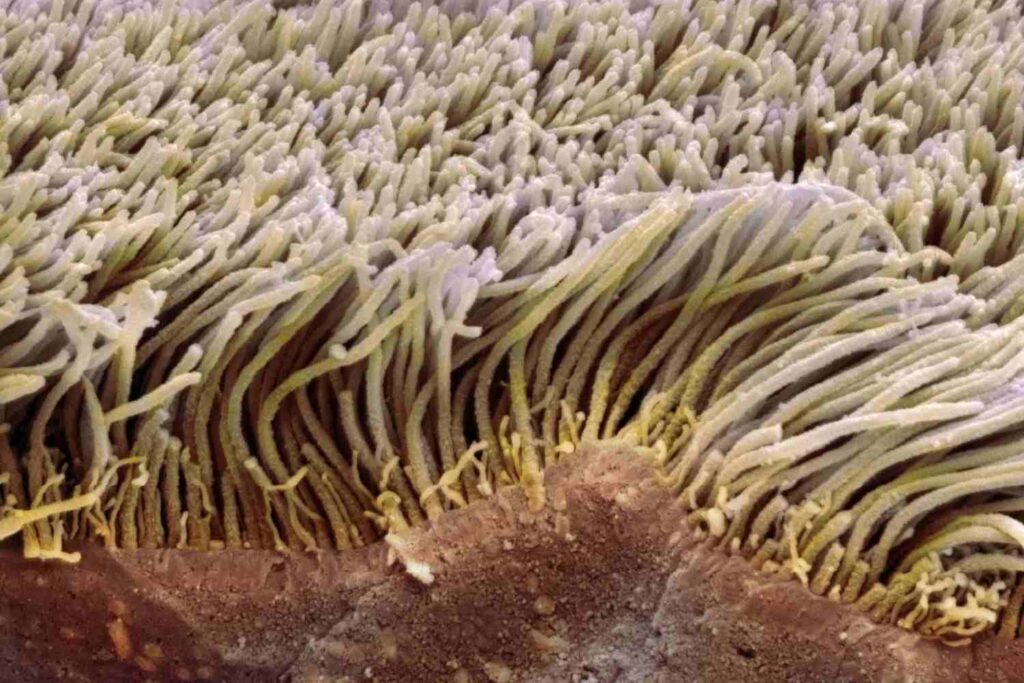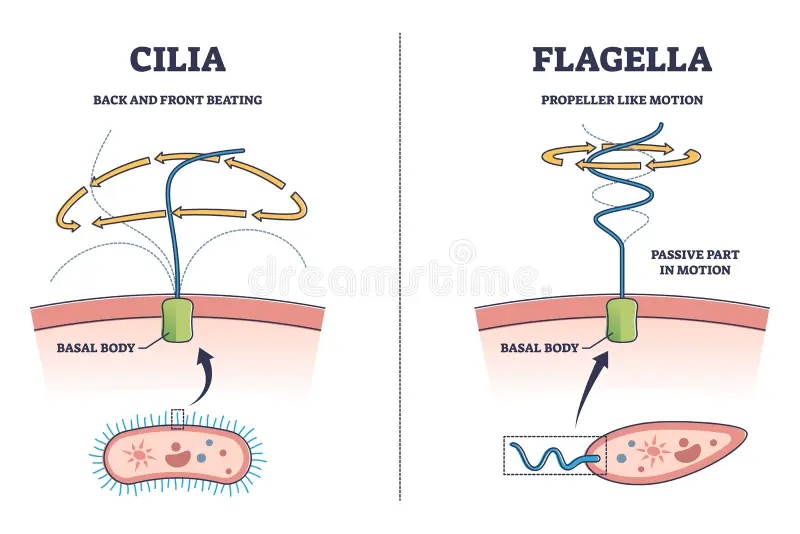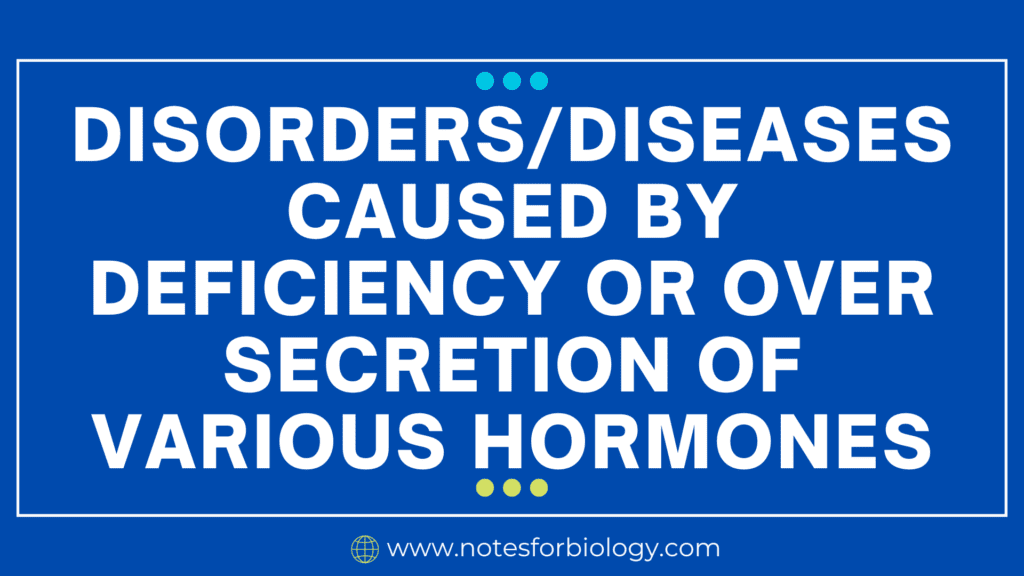1. Definitions
Cilia are short, hair‑like structures on the surface of many eukaryotic cells. They beat in coordinated waves, much like tiny oars, to move fluid, mucus, or even the cell itself.

Flagella are long, whip‑like appendages used for movement. Depending on the organism, flagella can propel an entire cell, such as sperm, or help single‑celled organisms swim.

Table of Contents
Why It Matters
Understanding the differences between cilia and flagella helps us appreciate how cells move, interact, and maintain health. From cleaning our lungs to enabling sperm to swim, these tiny structures power many life‑essential processes.
19 Major Differences

Here they are, organized for clarity:
| SN | Feature | Cilia | Flagella |
|---|---|---|---|
| 1 | Size and Length | Much shorter (∼5–10 µm) | Long (∼10–200 µm) |
| 2 | Number per Cell | Dozens to thousands | One to few (commonly 1–3) |
| 3 | Movement Style | Coordinated, wavelike (power and recovery strokes) | Undulating, whip‑like or rotational |
| 4 | Primary Function | Move fluid/mucus over surfaces; some sense environment | Propel cells (e.g., sperm) or sensory functions in single‑celled organisms |
| 5 | Occurrence in Organisms | Found in most multicellular (e.g., human airways) & some unicellular | Found in many unicellular organisms and some specialized multicellular cells |
| 6 | Structural Core | 9+2 microtubule “axoneme” structure | Same 9+2 structure (eukaryotic), 9+0 in prokaryotic flagella |
| 7 | Type of Motion Force | Powered by dynein arms causing sliding between microtubules | Powered by dynein (eukaryotic) or flagellin rotation (prokaryotic) |
| 8 | Energy Source | ATP (dynein ATPase) | Euk: ATP; Prok: proton motive force (PMF) or sodium motive force |
| 9 | Sensory Roles | Sensory cilia detect chemical/mechanical signals | Flagella mostly for movement; some sensory in single‑celled organisms |
| 10 | Regeneration | Continuously replaced | Regen in single‑celled or lost via resorption in multicellular |
| 11 | Anchorage | Anchored in basal body “ciliary rootlet” | Anchored in basal body or flagellar motor apparatus |
| 12 | Surface Coverage | Blanket‑like coverage on cell surfaces | Usually singular or few per cell |
| 13 | Beat Frequency | High (5–20 Hz) | Slower undulations |
| 14 | Coordination | Beat in metachronal waves | Not coordinated waves (cells often have only one flagellum) |
| 15 | Examples in Humans | Respiratory tract, fallopian tubes, ventilating brain | Sperm motility; none else |
| 16 | Prokaryotic Units | Absent in prokaryotes | Present and simpler (flagellin helix, rotary motor) |
| 17 | Genetic Disorders | Primary ciliary dyskinesia affects mucociliary clearance | Few genetic diseases; mostly bacterial flagella studied in pathogens |
| 18 | Functional Specialization | Motile cilia (movement); primary cilia (sensory) | Motile flagella (movement); sensory flagellum in protists |
| 19 | Structural Rigidity | Stiff during power stroke, flexible recovery | Highly flexible whip‑like structure |
Deep Dive into Each Difference
1. Size and Length
Cilia measure about 5–10 micrometers, while flagella can stretch up to 200 micrometers—a huge difference at the microscopic scale.
2. Number per Cell
A single cell might sport a “lawn” of cilia, working together. Flagella, by contrast, are fewer – often singular appendages.
3. Movement Style
Cilia perform whip‑like power strokes followed by gentle recovery strokes, creating fluid flow. Flagella undulate in waves or rotate, leading to cellular movement.
4. Primary Function
Cilia often move substances like mucus; flagella primarily move the cell itself, like a boat’s propeller.
5. Occurrence in Organisms
You’ll find cilia lining your lungs; flagella are common in bacteria or sperm cells, but rare in most mammals.
6. Structural Core
Cilia and eukaryotic flagella share the 9+2 microtubule structure. In contrast, bacterial flagella emerge from a rotary motor.
7. Type of Motion Force
Dynein molecular motors in cilia slide microtubules. Bacterial flagella rotate via tiny motors powered by ion flow.
8. Energy Source
Eukaryotic cilia and flagella use ATP; bacterial flagella use energy stored in proton gradients.
9. Sensory Roles
Primary cilia on cells sense signals; flagella on protists assist in environmental detection.
10. Regeneration
Cilia are continuously renewed; flagella can regrow or be resorbed when cells differentiate (e.g., sperm development).
11. Anchorage
Both structures anchor via basal bodies, though with different organizational rootlet systems.
12. Surface Coverage
Cilia line surfaces densely; flagella protrude as one-off structures for propulsion.
13. Beat Frequency
A coordinated “wave” of cilia can beat 5–20 times per second—flagellar undulations are slower.
14. Coordination
Cilia rhythmically beat in waves. With usually one flagellum, coordination isn’t needed by individual cells.
15. Examples in Humans
Cilia move mucus and eggs; flagella are central to sperm mobility.
16. Prokaryotic Units
Prokaryotes lack cilia but have simpler, singular flagella – both physically and genetically different.
17. Genetic Disorders
Ciliary defects can cause chronic respiratory problems; flagellar disorders are less common but important in bacterial disease.
18. Functional Specialization
Motile cilia move fluids, primary cilia sense signals; flagella can be motile or sensory depending on the organism.
19. Structural Rigidity
Cilia are crafted for resilience in power/recovery beats; flagella excel in waving flexibility.
Why These Differences Matter
- Health & Disease: Defects in cilia cause respiratory infections or infertility. Flagella differences help identify bacteria and are targets for antibiotics.
- Evolution: Comparing cilia and flagella unlocks insights into how organisms moved and adapted.
- Biotech: Learning how flagella rotate has inspired nano‑machines; cilia inform microfluidic devices.
Microscopic Observation
- Light Microscopy can show cilia in airway cells or sperm flagella.
- Electron Microscopy reveals the 9+2 microtubule arrangement.
- High-Speed Imaging captures ciliary beats or flagellar waves in real time.
Real-Life Cases
- Primary Ciliary Dyskinesia (PCD): Genetic cilia disorder leads to chronic infections and infertility.
- Bacterial Flagella: Seen in pathogens like Salmonella, flagella enable infections and are targets for vaccine design.
Lab Techniques
- Immunofluorescence uses antibodies to stain cilia or flagella.
- High-speed video tracks ciliary beat patterns.
- Genetic assays identify ciliary genes in human conditions.
Conclusion
While cilia and flagella might look similar, they’re distinct in length, number, structure, motion, function, and evolutionary origin. Understanding their 19 key differences sheds light on everything from lung health to bacterial movement—and even informs drug and bioengineering breakthroughs.
Whether you’re studying cell biology, medicine, or microbiology, grasping cilia vs flagella is essential. Let me know if you’d like illustrated diagrams, a comparison chart, quiz, or flashcards to help reinforce your understanding!
FREQUENTLY ASKED QUESTIONS
What are cilia and flagella?
Cilia and flagella are microscopic, hair-like or whip-like structures that extend from the surface of cells. They are used for movement—either moving the cell itself or moving substances across the cell surface.
How do cilia and flagella differ in length?
Cilia are short (about 5–10 micrometers).
Flagella are much longer (up to 200 micrometers or more).
Do prokaryotes have cilia?
No. Prokaryotes like bacteria do not have cilia. They have simpler flagella made of a protein called flagellin, which rotate like propellers.
Related Articles




